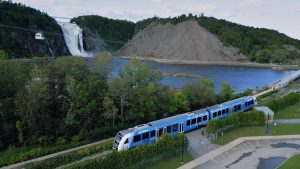Alstom announced the first results of North America’s first demonstration of hydrogen-powered trains. The Coradia iLint carried more than 10,000 passengers, over 130 trips spanning 10,660 kilometres in Quebec this summer from mid-June to the end of September. The demonstration saved our railway partner an estimated 8,400 litres of diesel and averted 22 tons of CO2 emissions compared to the diesel trains that normally service this route [1]. Moreover, Alstom and its partners welcomed 34 commercial, governmental and regulatory delegations from all over North America looking to witness this hydrogen-propulsion technology and capture the requirements for wider implementation across North America.
Only 1% of the North American rail network is electrified today. To decarbonise the rail sector in time to meet national, provincial and state-level climate goals, there must be significant investments in track electrification along with the adoption of alternative green traction solutions, including battery-powered and hydrogen-powered trains. Alstom conducted this first-time-in-America demonstration as a proof of concept in real operating conditions for hydrogen trains, which bring multiple benefits, including no carbon emissions from the propulsion system, quieter operations, and a greater operational autonomy before refuelling than battery-powered trains.
Alstom is partnering with the Hydrogen Research Institute of the Université du Québec à Trois-Rivières to analyse the results of the demonstration project and will issue a final report for public authorities in early 2024.
Alstom’s Coradia iLint is the world’s first hydrogen passenger train. It has travelled more than 220,000 kilometres in eight European countries since it started commercial service in 2018. The train is powered by a hydrogen fuel cell that emits only water during operation while ensuring a quieter environment for passengers and those close to tracks. With the demonstration project in Quebec, the hydrogen train proves that it is a viable alternative to diesel on non-electrified lines with low density over long distances for clean, safe and sustainable operation.

via Press Release


